Four-image NAVCAM montage comprising images taken on 2 September from a distance of 56 km from comet 67P/C-G. Pay particular attention to the neck region for a closer view of the activity presented in OSIRIS images last month.
As described in previous blog posts NAVCAM image sequences are now being taken as small 2 x 2 rasters, such that roughly one quarter of the comet is seen in the corner of each of the four images. The four images are taken over an approximately 20 minute period, meaning that there is some motion of the spacecraft and rotation of the comet between the images.
The four images are shown separated by black borders and there is some overlap between adjacent frames, so that some features appear in more than one image. The images have been cleaned to remove the more obvious bad ‘pixel pairs’ and cosmic ray artefacts, intensities have been scaled to show a wide range of features, and the montage has been cropped to remove most of the black space around the comet. The dark feature in the centre is an imaging artefact.
Thank you to those of you who produced and shared your excellent mosaics using images from the CometWatch update posted on 1 September; we hope you enjoy mosaicking the images in this release, too (posted below as individual JPEGs of the four 1024 x 1024 pixel full-frame ‘corners’). As before, you are welcome to post them on your personal profiles with the ESA/Rosetta/NAVCAM credit line, and share a link to your work in the comments box below, so that we have the possibility to follow up with you and eventually post your efforts on this blog.
More images next week!

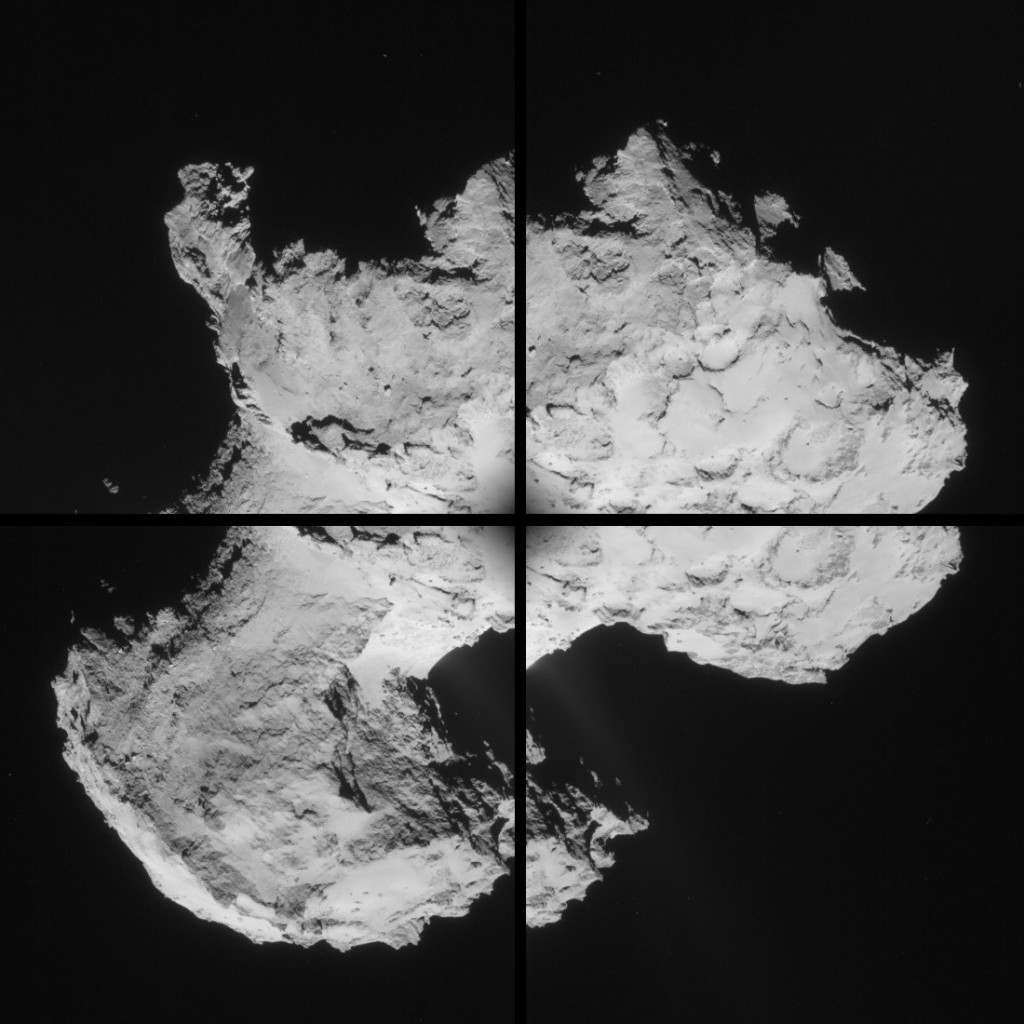
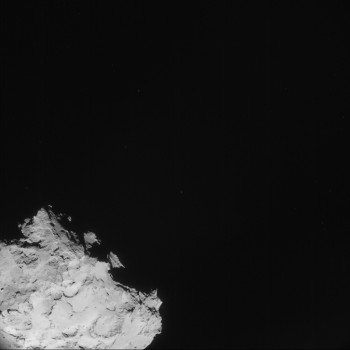
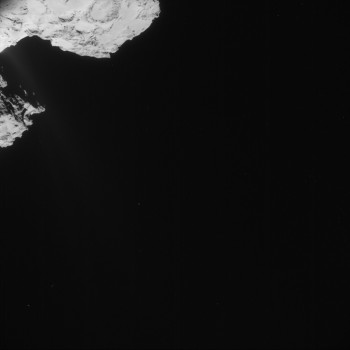
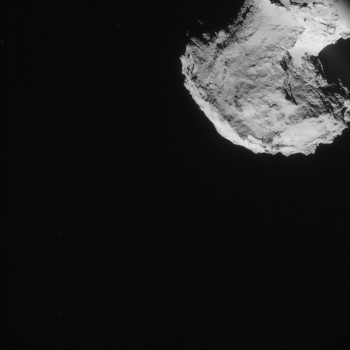
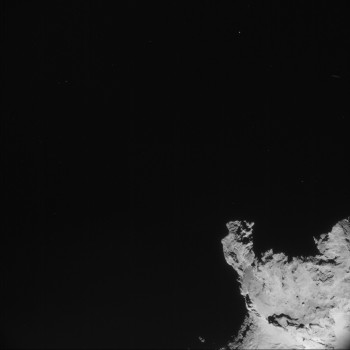








Discussion: 56 comments
Thank you very much Emily. 😀
This proves how good the NavCam really is. The NavCam although primarily used for navigation also doubles up as a great science camera (as I said before).
The detail on the nucleus is astonishing and the very weak, faint outgassing from the ‘neck’ is plainly visible in these NavCam images.
Excellent stuff. 😀
On the seconde full-frame image, there seems to be a blurry jet eminating from the commet.
Is this actual comet activity, or some sort of image artifact?
Here’s my attempt using Microsoft ICE and Paint.NET
https://2.bp.blogspot.com/-8ijAcYKpB2o/VAh2t-CGcWI/AAAAAAAAAFQ/VHhTVlBeFHg/s1600/ESA_ROSETTA__NAVCAM_20140902_stitch.jpg
Nice job Stuart!
Outgassing clearly visible, like a jetstream from the neck. Hope due to the comet’s rotation Rosetta doesn’t cross it. Can’t be good for the camera’s. Great pictures, thanks for sharing these with us!
Hello Rosetta-Team,
The image is rotated, cropped and enlarged to 200%.
https://www.raumfahrer.net/forum/smf/index.php?action=media;sa=item;in=33513
Great pictures, thanks for sharing these with us!
Great work Gertrude.
…
Such a beautiful beast! 🙂
Great angle.
The right side of the head remains the more freshly exposed surface of 67P. Until now…
Hi Gertrude, what a fabulous rendition of the 4 pictures to get a full view of the comet.
Did you notice the 2 upright Stone megoliths standing next to each other on the smooth part of the neck?
A Space Odyssey
Hello Dave,
Yes, a fascinating comet
Here is my contribution 🙂 https://www.planetary.org/blogs/emily-lakdawalla/2014/09040955-latest-rosetta-navcam-images.html I think I see some coma in two other areas near the comet, besides the obvious jets.
Hope those delicate stalagmites over the ‘neck’ resist the perihelion.
Under the chin.
Some electro-magneto-viscocity physics well beyond my aged neurons.
Enhancing the jet by tonemapping using FDRTools
for sector B, see
https://twitter.com/dermuehle/status/507601331649933312/photo/1
and possibly a diffuse brightening in sector A
https://twitter.com/dermuehle/status/507610045014482946/photo/1
‘Radiating’ like antennas.
Thanks a lot Wolfang
(Or reflexing like mirrors?)
Two image montage of Comet 67P/C-G on 2 Sept 14 showing dust jets and masked overlay of nucleus.
https://i142.photobucket.com/albums/r91/wilga_photo/Oppy/ESA_ROSETTA__NAVCAM_20140902B—jets_merged_half_pano1a–post.jpg
Image source: ESA-Rosetta
My mosaic and enhancement here on facebook https://www.facebook.com/photo.php?fbid=769073246467029&set=a.126685950705765.8723.100000930830205&type=1
Great pictures indeed! But it looks to me like it might not be just the cameras but even Rosetta itself that might be in danger if it crosses the path of those jets coming out of the neck region.
Thank you for the images, fascinating to look at and wonder! When do you expect the comet to start ‘fizzing’. Hopefully not before ‘Philea’ does it’s landing thing!
I put together two composites. One to emphasis the out gassing. The second is to help show surface detail.
https://celestialimaging.blogspot.com/2014/09/sep-2-composite-of-comet-67pc-g.html
Errol,
great pictures.
What makes you think water is outgassing from beow the surface?
The jets look unusual in that they are so like filoments, would you not expect sublimenting ice to expand out in all directions as soon as it was free from the surface?
Quote from recent Planetary Society displayed image “Rosetta took a long-exposure image with its wide-angle camera on August 2, 2014, to observe jets of dust escaping from the comet. The photo was taken from a distance of 550 kilometers. ”
You can see the OSIRIS image displayed at the Planetary Society. https://www.planetary.org/multimedia/space-images/small-bodies/comet-cg-20140802-activity.html
It would seem that either under long exposure, or increased brightness to the image that the jets can be seen. Now the jets might simply be dust as described in the image capture. Just commenting on the observed flume, whether it is dust, ice, or gases. Its not unheard of a comet, acting like a comet with jets. 🙂
Maybe there are actual crystals inside those filaments.
Or just plasma light. Instruments will tell.
It is not just the Solar light and warmth. Solar wind is hitting 67P in full force.
So we are watching strong electromagnetic forces at play, too.
I see no jets or outgassing at all, what i see is a side in shadow illuminated from scattered light. A lot of persons wants to see some volcanic activity on this lump and went-holes and so on. These things happen in Hollywood.. There soon will be a sort of fog but this will have its origin from the surface and not from the deep inside. The only scenario where large amounts of material gets ejected is when the neck collapses a bit due to the pressure of the two components.
Hi NavCam team,
here are a couple of our processing: https://www.aliveuniverseimages.com/speciale-missioni/missioni-nel-sistema-solare/rosetta/925-esa-rosetta-i-getti-della-cometa-67p-visibili-anche-nelle-immagini-della-navcam
Here is the full montage with a masked overlay showing two active jet areas: one narrow collimated group of jets to the upper left originating in the north polar area of the comet and another broad jet to the lower left arising in the large equatorial plain on the larger comet body. The broad circular patch to the right center is a camera reflection artifact.
https://univ.smugmug.com/Rosetta/i-NTc4385/0/M/ESA_ROSETTA__NAVCAM_20140902B%5B-%5D–jets_merged_full_pano1-L.jpg
–Bill
Love this montage, Bill.
Bill, thanks for the picture, good view of the out gassing.
However why is the outgassing occuring from the neck (in the sun) and from the base (does not look like its in the sun) occurring at the same time?
On a previous comet one of the project scientists was also surprised that just as amny jets were coming from the dark sides as the sunlit sides.
Can the heat from the sun be the source ofboth jets in this instance?
Or is the sun not the prime cause of jets?
Is it something like a plasma envelope heating all of the surface?
This is the 7 Aug 14 OSIRIS image showing the suspected source of the collimated polar jets. Note the lineation of pits and disturbed regolith in the center above the line of boulders. There should be interesting changes in this area over the next few weeks.
https://univ.smugmug.com/Rosetta/i-K9tRrwf/0/L/ESA_Rosetta_OSIRIS_140807b-1024×1024–stereo-R–active_region-L.jpg
Source: ESA/Rosetta
–Bill
Bill,
does the line of the pits align with the apparent movement of the sun across the Comet, or is it alligned in some other direction.
Also why a line of pits from an even spread of sulight, the coment is small so i would exopect the sunlight to be roughly equal across the surface, the comet is black so would not expect to much sunlight to be concentrated from reflection off surfaces.
In which case I would think that there would be clusters of pits, not staight line of pits.
Do you have any ideas to clarify?
On 4x zooming see them. Could confirm them on the original? I am fearful of .jpeg artifacts (ringing). Thanks a lot, Bill.
Mosaic and enhancement of comet 67/P (C-G) from ESA/Rosetta satellite on 2014 September 2. More details!
https://www.facebook.com/photo.php?fbid=769380589769628&set=a.126685950705765.8723.100000930830205&type=1
Thanks for sharing those impressive images.
If there is activity what is the source of this activity other than Solar heating, bearing in mind that the measured temperature is -70 Centigrade which seems a bit warm for outer space!
Is there another source of heating in the Comets core? The size and mass of the Comet could explain this and also give an answer about the sculpting of the neck of the Comet where out gassing is going on all the time.
What if it has an incandescent core, what is driving it?
Clive
Started as a mental game, but what about some ‘ice jewels’ inside the core? 😉
Not sure about the sculpting of the neck, but the comet was formed by two similar sized objects merging. The neck is simply where the two joined and fused. Its like attaching a jaw breaker at the end of say a peanut.
Fully agree about the jaw.
You sure about it being fused? Look like ablation of the center to me. I wish I was there to stick it with a pick and get a sample!
Mosaic and enhancement of comet 67/P (C-G) from ESA/Rosetta satellite on 2014 September 2. The jet look like coming out from an area large about 150 meters and the lenght of the brighter part is about 1200 meters.
https://www.facebook.com/photo.php?fbid=769493053091715&set=a.126685950705765.8723.100000930830205&type=1
First at all, my congratulations to the rosetta team for the sustained success of the mission!
For ten years I have been looking forward to the arrival of Rosetta at 67P and the images we will see within the next months.
The NavCam images of 2. September for me are the most interesting up to now, because it seem to be possible to visualize the origin of the jets better than before. I could not resist to create a montage, separate the faint jets from the original images and display them in a different color. The aim of this montage was to create a nice, but nevertheless exact view of Churyumov-Gerasimenko with its (most prominent) jets. At some places in the image I had to work with masking tools, especially in the boundary region between the jets and not illuminated features of the nearby limb.
North is roughly up in the image:
https://www.beugungsbild.de/67P/67P_20140902_navcam_processed.jpg
I don’t know– we see the dust and gas jets in the general area and we observe these features. They may or may not be related. As the comet heats up and as Rosetta gets closer we’ll have better views. But this is an early image useful for comparative purposes.
And remember on the Equatorial Plain, there is a pulse of heat from insolation every 6 hours, and a time lag from thermal inertia. Again, the more that we will see, the more we will learn.
–Bill5307
My new nice contribution (not easy to do well) for the fusion of these 4 images:
https://www.flickr.com/photos/alpi-costerni/15149831901/
without stitching Errors and this mean without rocks and terrain elements doubled, as I have seen here up somewhere else, probably on all others …
Great overall cleanliness and balance of the different light intensity, including the light outgassing.
I have gone ahead and sequenced the released images since the 6th into an animation up to the Sep 2nd captured images.
https://celestialimaging.blogspot.com/2014/09/30-days-of-comet-67pc-g.html
If we already observe columnated jets, then there should be vents responsible for those jets… according to standard theory. The jets cannot be due to anything on the surface or we would see an expanding cloud, not confined streams.
It’s the white areas in the neck region which I find the most intriguing feature of the whole thing. Surface ice has now been ruled out by mission scientists, so what’s causing them? Could they be a photographic white-out effect due to electric discharge activity? (which would also neatly account for the origin of the collimated jets apparently emanating from precisely that region…).
The highest potential delta should be there. 🙂
Some Ozone?
If regolith smell of ‘powder’ then 67P should smell of marine battle.
😉
The ‘Nefertiti’ Layer…
Lady of The Two Lands, Mistress of Upper and Lower Egypt.
@ THOMAS
My understanding from watching the ESA hangout video is that there is no thing as white on the comet. The actual images are stretched so that the lightest color is white and the darkest is black, thereby using the full grayscale for greater detail. But the words by one of the ESA team members was that we are basically distinguishing between shades of very black to pitch black. Which means that anything appearing as white should not be mistaken for “potential exposed ice”.